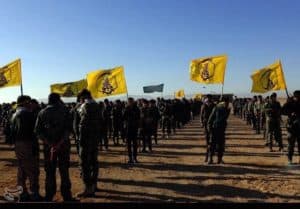
Photo 1. Afghan Fatemiyoun Division forces near Palmyra, posted Dec. 10.
As the pro-Syrian government coalition began declaring victory in east Aleppo on Dec. 11, the Islamic State retook the ancient city of Palmyra in eastern Homs and attempted to storm the T4 military air base. The base is near a strategic crossroads of routes that lead to Deir Ezzour, Raqqa, Damascus, and other key cities, according to The Guardian. Following this development, Syrian president Bashar al Assad vowed to retake Palmyra, accusing the West of encouraging the jihadist group to launch the attack in Homs in retaliation for “defeat” in Aleppo.
Iran has confirmed the deaths of two Islamic Revolutionary Guard Corps (IRGC) Ground Forces officers in the latest Palmyra battles. Captain Ahmad Jalali-Nasab (photo 2), who was attached to the IRGC-GF Imam Ali ibn Abi Taleb unit (Qom province), was announced killed in Palmyra on Dec. 13. The following day Hassan Akbari (photo 3), a Brigadier General or Brigadier General Second Class, was also declared killed. Akbari was a veteran of the Iran-Iraq War and was leading a sabotage battalion in Syria, according to state-affiliated Iranian media.
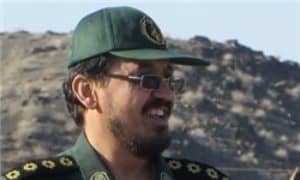
Photo 2.
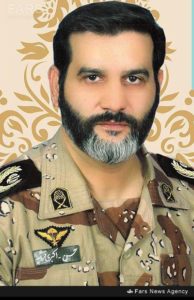
Photo 3.
The IRGC-backed Afghan Fatemiyoun Division has been fighting in Palmyra alongside the Syrian military and pro-Assad militias. The Fatemiyoun’s “special forces” were dispatched to the ancient city on Dec. 10 in an attempt to evict the Islamic State, according to Fars News. IRGC-affiliated Tasnim News published a report the same day after speaking with a Fatemiyoun commander, who claimed that units in tandem with the Syrian forces and Russian air power deflected the Islamic State’s attack. The following day, however, the Islamic State established full control over Palmyra. A photo posted on social media shows Islamic State fighters holding a Fatemiyoun flag (photo 4). Fighters also posted what appears to be a Pakistani Zeynabiyoun flag (photo 5), another IRGC-backed militia.
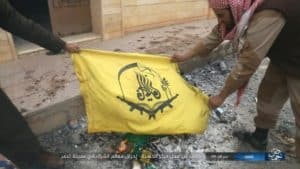
Photo 4.
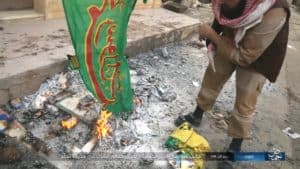
Photo 5.
The Fatemiyoun commander said that four battalions of the Hazrat-e Abolfazl Brigade had been stationed near Palmyra since participating in the operation to take the city in March. In that offensive, Lebanese Hezbollah played a big role, with the support of Iraqi militias. The IRGC-backed Imam Ali Brigade had forces stationed near Palmyra last week, as well (photo 6), according to social media posts.
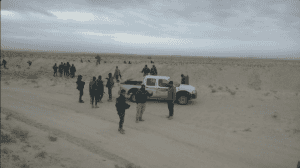
Photo 6. Iraqi Imam Ali Brigade fighters near Palmyra, Dec. 8, according to pro-regime social media post.
IRGC-GF officers have been on the ground in Syria since the early phases of the conflict, augmenting the Quds Force and advising and assisting pro-Assad Syrian forces. As the conflict devolved and Assad’s army dwindled, the IRGC mobilized its foreign Shiite proxies and eventually escalated the involvement of its own regular forces in coordination with Russia in September 2015. As the IRGC drew down its regular forces in May 2016 and relied more on Shiite proxies as foot soldiers, IRGC-GF officers from regular and Saberin special forces have continued to deploy to Syria. They can fill the vacuum of planning complex military operations against battle-hardened insurgents, and leading militias lacking that experience and knowledge. Elements of regular Iranian forces, however, continue to operate to Syria in support and direct combat roles.
The ongoing battle for Palmyra clearly illustrates that while the pro-Assad faction has achieved a significant victory in taking Aleppo, forces are both vulnerable and stretched. The Syrian war will continue to drain IRGC resources. The Guard can sustain its current model only as long as it can find foreign fighters and Iranians to volunteer.
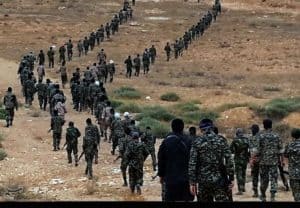
Photo 7.
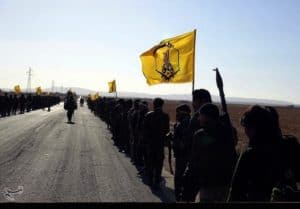
Photo 8.
Are you a dedicated reader of FDD's Long War Journal? Has our research benefitted you or your team over the years? Support our independent reporting and analysis today by considering a one-time or monthly donation. Thanks for reading! You can make a tax-deductible donation here.








4 Comments
Seriously, if we want to end this bloody civil war, the super powers have got to get their acts together. On one hand, they said they stopped the foreign fighters from joining the insurgents but, on the other hands they simply let in ten of thousands of foreign fighters to join Iraqi Shiite regime and Syrian Regime. By now, most of the foreign fighters fighting for the insurgents are already dead from American and Russian bombings so, how can the insurgents continue to stage another counterattacks such as retaking Palmyra. I think the number of insurgents remain the same throughout this war. The dead foreign fighters are being replaced by local population. I think, most if not all of the insurgents now are local Iraqis and Syrians. I think they decided to take up arms because they saw the influx of foreigners fighting for the Shiite Regimes. So, unless we stop all foreign fighters from coming regardless of which sides they are fighting for, this bloody civil war is not going to end any time soon. Unless of course, the American and the Russian just want to keep selling their weapons and make profits out of this senseless war.
That’s rather obviously slanted. For example: “an attempt to evict the Islamic State” reflects American tactics, not what the Iranians do. Suleimani (Soleimani) implements surround-and-annihilate all across the Syrian and Iraqi theater of battle.
Then this: “The Syrian war will continue to drain IRGC resources. The Guard can sustain its current model only as long as it can find foreign fighters and Iranians to volunteer.”
That ignores the difference between IRGC and Quds Force. The Quds guys are all volunteers. Also that the bulk of fighters in Syria on the anti-Jihadi side are Syrian, Lebanese, and Iraqi. The pro-Jihadi side can be seen here:
http://i.imgur.com/98j1tur.png
Tunisia includes Libya, Russia includes Chechnya. Basically they are dirt-cheap mercenaries. There are also suicide bombers formed up distinctly to their own teams.
Why DAESH would throw 400 of its dwindling corps of fighters off to Palmyra is unclear. This was an expensive operation and they are now cut off from resupply. Like the second battle there, these fighters will be surrounded in place. Then the drones and artillery will pick off their leaders. Annihilation follows almost certainly. DAESH remains incompetent at defense. Were these fighters sacrificed to snag Internet hits ??? To make the news? That all?
I don’t understand why the air base wasn’t bombed to destroy the weapons cache or bombed
while the invaders were picking over the weapons. Two birds with one stone . Where is real time intelligence when you need it ?
Syria is turning into an opened ended and bottomless commitment for both Russia and Iran. They win a battle in Aleppo and lose Palmyra in turn around. The Iranians loose two senior officers no doubt by surprise. These people have fought each other for thousands of years and now they have very few Americans to distract from their traditional enemies. The fighting will go on till they get tired of it one more time.